Canon EOS R: A deep-dive Q&A session with the Canon engineers
posted Saturday, September 15, 2018 at 8:12 PM EDT
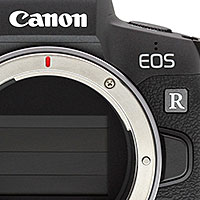
Canon's new EOS R full-frame mirrorless camera has stirred a lot of buzz, and I'm sure readers will have as many questions as we've had about it.
I had a chance to sit down with a panel of top Canon engineers at the recent product launch event in Hawaii, and ask all my usual techie questions; the results were very gratifying :-) (This is a big reason why I'm willing to invest the time to travel to launch events like this one and Nikon's recent one in Japan; there's no substitute for being able to talk with the engineers directly, to ask the sorts of questions I always have.)
It was a really interesting session, and we covered a lot of ground in the ~40 minutes I had with them. Here's what I came away with; let me know what you think of it, and feel free to ask other questions you might have in the comment section below. I'll try to get any additional questions answered by our PR and engineering contacts at Canon...
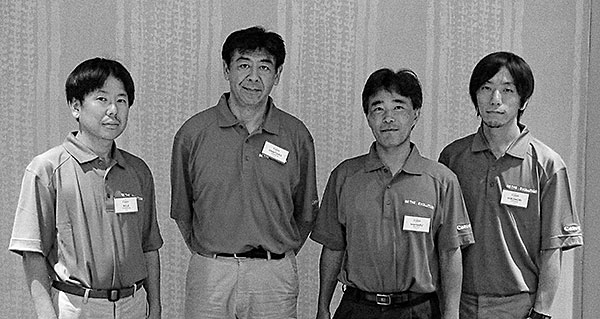
Canon EOS R Autofocus - 5,655 points?! Really?
The very first question I had for the engineers was what on earth the spec of 5,655 "selectable" autofocus points meant. Even if there were that many, how the heck could you ever meaningfully select between them?
Also, in shooting with the camera, whenever it displayed an "AF point" that was active, it showed a pretty normal-sized green box on the display. It didn't seem like many more than 100-150 such boxes could fit on the screen. (Note added later: I think the number of separate "boxes" on the screen is 143.)
So what's the deal with the 5,000+ points spec?
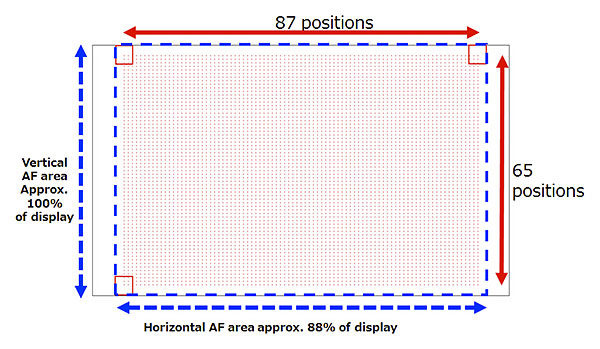
It turns out what's being referred to are the number of AF point positions you can choose from, when in single-point mode and using the rear-panel arrow keys. When you press one of the arrow keys, the box showing the single AF "point" moves a small step in the chosen direction. Adding up the number of steps in each direction, you'd likely come up with the claimed 5,655 points.
I suspect that you that have the same resolution in choosing where to locate an AF box when you're dragging the box around with your finger on the LCD. But the 5,655 points don't correspond to what we traditionally thought of as autofocus points from the era of SLRs, when phase-detection autofocus systems used separate, dedicated sensors. Other than the fact that both types of system use phase-detection to determine the degree and direction of defocus, they're really completely different animals. Personally, I'm not happy with referring to "5,655 individually selectable AF points", but am honestly not sure what would constitute meaningful language.
On the other hand, Canon is making an important point here, even though it feels like the vast number of "selectable AF points" seems a little misleading. Other companies' on-sensor PDAF technology requires pixels to be either phase-detect pixels or image-forming pixels. So there is in fact a limitation to how many AF points they can create, and thus where they can be located. (It's widely known that conventional on-sensor PDAF systems can produce very noticeable artifacts under just the wrong subject detail and illumination conditions.)
Canon's unique Dual-Pixel AF technology means that every pixel on the sensor can simultaneously be used for phase-detect focus determination and to create the image. Basically, an AF point could be anywhere on the array.
So, while there's an entirely separate question of how the camera system manages all of the possible AF-point locations, Canon does have a unique advantage, in that the processor can essentially form an AF point anywhere on the sensor surface, because every pixel in the array (at least anywhere that can "see" light rays coming from both sides of the lens) can be used as a focus pixel if desired, without producing any artifacts in the image.
EOS R AF points are all line-type
In conventional phase-detection autofocus systems, autofocus points can be either "line" or "cross" type, depending on what orientations of subject detail they're sensitive to. Line-type points can only "see" subject detail oriented around one axis (horizontal or vertical), cross-type points can detect and respond to subject detail in either direction.
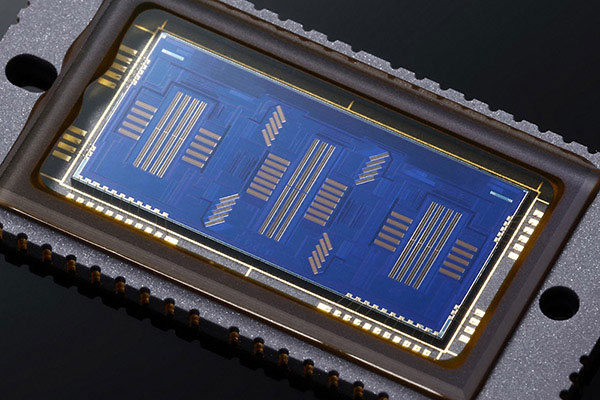
Copyrighted image provided courtesy of Canon.
As is the case with the new Nikon Z7 and Z6 full-frame mirrorless cameras, the autofocus points in the EOS R are all horizontally-oriented line-type points, meaning they're sensitive only to subject detail in that direction. (The terminology can be a little confusing; horizontal points are sensitive to detail that's horizontal, meaning vertically-oriented objects. As an example, horizontal points can focus on picket fences, but not on window blinds.)
This seemed like a weakness to me, but when I asked the Canon engineers about it, they gave essentially the same answer the Nikon engineers had about the Z7: Thanks to the very high density of AF points, the chances of missing focus on a subject because it has no horizontal detail are very low. Even with a subject like window blinds, if the camera is the tiniest bit tilted relative to the subject, an edge of a slat (for instance) would cross an area covered by an AF point, letting the camera focus.
We'll see how this plays out in practice. So far, shooting normal real-world subjects with the EOS R (and the Nikon Z7, for that matter), we didn't see it obviously missing focus. We'll take a careful and detailed look at both new mirrorless systems back in the lab. (We brought an EOS R back with us from Hawaii, and should have a Z7 in the lab very soon as well.)
How did they manage 100% vertical AF coverage?
(This is related to the above, but I didn't make the connection until they explained it to me...)
I was very surprised to see that the EOS R's autofocus points cover 100% of the frame vertically. Phase-detect AF needs to be able to "see" light rays coming from both sides of the lens, to be able to discern subject distances (or actually, out-of-focus-amounts), so you generally can't have them running right up to the edges of the frame. So how do they get 100% vertical coverage?
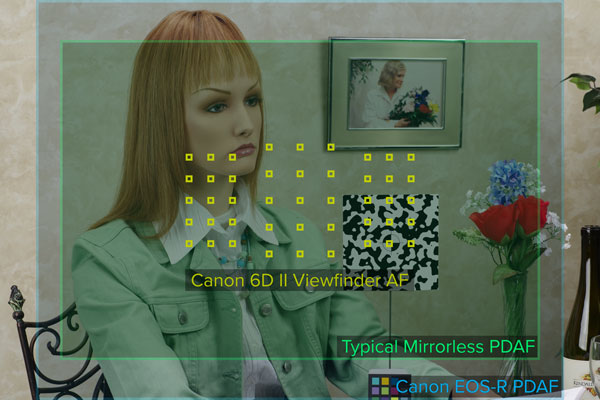
Duh... The EOS R's PDAF points are all line-type horizontal points, so there's no need to be able to see light rays from the top and bottom of the lens. So it's no problem having 100% vertical coverage. (Which makes me wonder why the Nikon Z7 doesn't also have 100% vertical coverage, vs. 90%.)
Does AF coverage change with EF-mount lenses?
Since EF-mount lenses used via the adapter are so much further from the sensor surface, it seems likely that they wouldn't be able to support as large an AF area as native RF-mount ones. I asked, and it turns out this is true. It will vary some based on the specific lens design, but some EF-mount lenses won't have quite as wide AF coverage as the native ones. Native RF-mount coverage is 100% vertically and 88% horizontally, but some EF-mount lenses will only have 80% horizontal coverage (again, depending on the specific lens design).
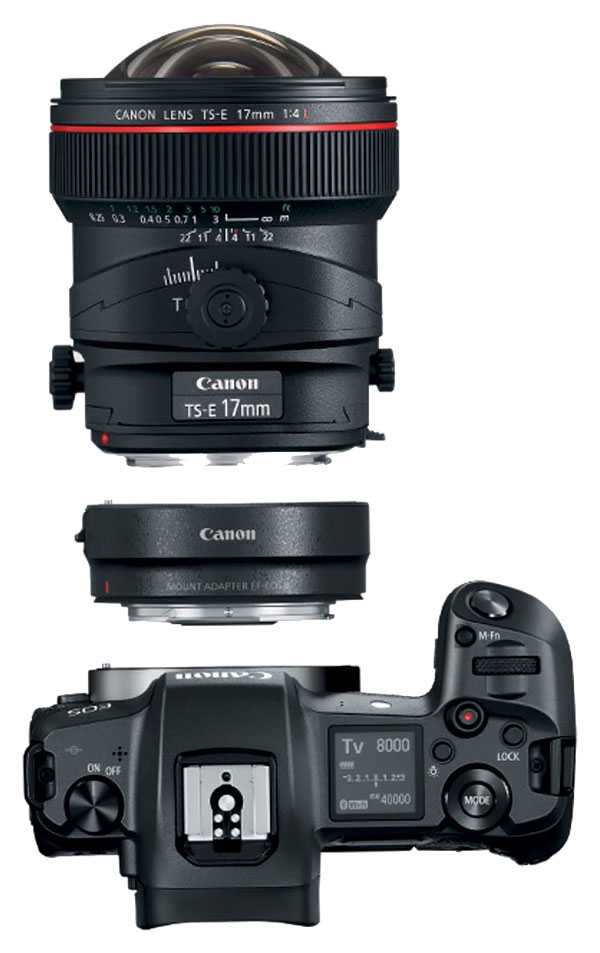
The EOS R's autofocus is phase detect-only
This was a bit of a surprise. Conventional DSLR lenses are designed to work with SLR phase-detect autofocus systems, whereas lenses designed for mirrorless systems generally need faster AF actuators, so they can respond quickly enough to work with a contrast-detect AF (CDAF) approach.
Most mirrorless cameras use a combination of PDAF and CDAF; phase-detect gets the lens close to the correct focus, then contrast-detect fine-tunes it. This appears not to be the case with the EOS R, though. When I asked whether it had a hybrid AF system, the engineers replied that no, it was always only phase-detect. (They seemed particularly proud of this, that their PDAF is accurate enough to take things to final, optimal focus.)
Given that this is the case, it makes sense that existing EF-mount lenses would be able to focus every bit as quickly on the EOS R as on any conventional EOS SLR body.
How does EOS R autofocus compare to cameras like the 5D Mark IV?
We're talking a lot about autofocus, because that's really the defining issue between mirrorless cameras like the EOS R and conventional SLRs like the 5D Mark IV, 1D X Mark II or the 6D Mark II. Conventional separate-sensor PDAF systems have reached an incredible level of sophistication and ability, so matching their performance is the defining challenge of the mirrorless revolution.
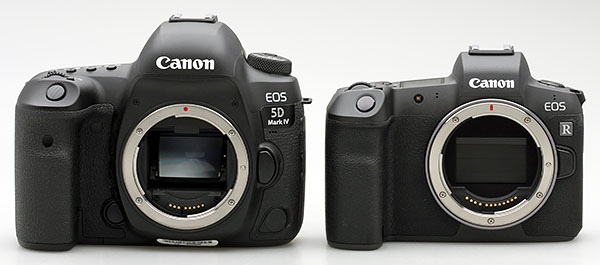
So how does the EOS R's AF system stack up against those of Canon's SLRs?
Even as I asked the question, I knew there wasn't likely to be a single, simple answer. "Autofocus performance" isn't a single number, as there are nearly as many different autofocus scenarios as there are subjects. A racing car, a bird against the sky, a football player dodging tackles; the autofocus challenges for each are completely different. So an AF system that works well for one may not be ideal for another.
Of course, some AF systems can't get out of their own way, even with a static subject...
So it's no surprise that the engineers response was a little equivocal, but I think that's an excellent sign for the EOS R. They said that relative AF performance depended on the subject; that the EOS R would win sometimes and the 5D IV or 1D X II other times. They didn't elaborate on what subjects they thought each would be best at, but I thought it was significant that it wasn't all one way, and that the EOS R in fact would win some AF matchups, even against some of Canon's top SLRs.
How did they end up with the 20mm flange depth? Is that a limitation?
Flange depth is the distance from the front face of the body flange to the surface of the sensor, and it's a key parameter for optical design.
Being able to position a large rear lens element very close to the sensor brings a lot of advantages for optical design, and Nikon make a big point of this in talking about their new Z-mount, which has a flange depth of only 16mm.
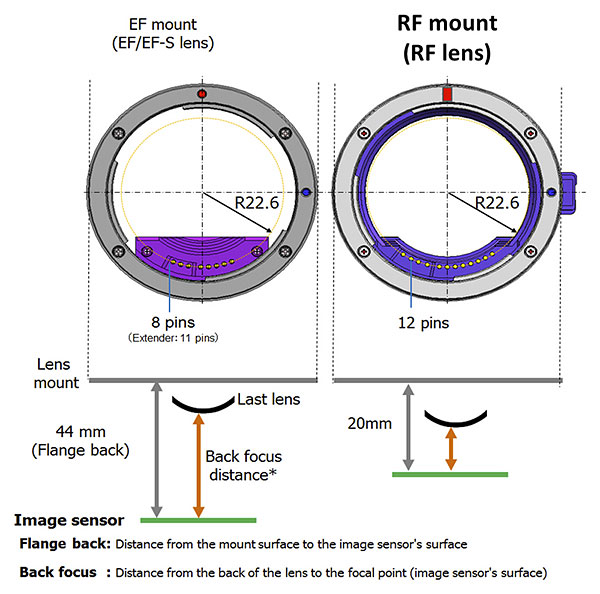
Given its importance for optical design, Canon's choice of a 20mm flange depth seemed like a limitation, so I asked them: How did they make the decision to go with that dimension?
The answer surprised me: It was all about strength and ruggedness. They said that their first consideration in choosing the flange structure was the physical ruggedness of the system, and they felt that 20mm was what they needed to meet their goals for overall strength.
But what about the optical consequences? Doesn't a greater flange depth mean negative tradeoffs for optical design?
Not necessarily: The engineers pointed out to me that what matters is the back-focus distance, not necessarily the flange depth. Back-focus distance refers to how far the rear lens element is from the sensor's surface. We tend to talk about flange depth, but it's the back focus distance that actually matters optically, and lens designers can pretty much place that wherever they want in a mirrorless design, regardless of the flange design. Theoretically, lens designers could have lens elements projecting back into the camera body as far as they wanted, but as a practical matter, you need to be careful that a projecting rear element be properly protected for times a photographer might set the lens bottom-down on a table or other surface.
Still, as the engineers pointed out to me, using the new RF 50mm f/1.2 lens as an example, putting the rear element nearly flush with the mount fingers means that it's a good 2-3mm closer to the sensor than you'd expect, just based on the flange depth.
How will the optical quality of the new RF-mount lenses compare with the best EF-mount ones?
With all the talk of how much the combination of a large flange diameter and short back-focus distance help optical design, I naturally wanted to know just how much of a difference it actually made.
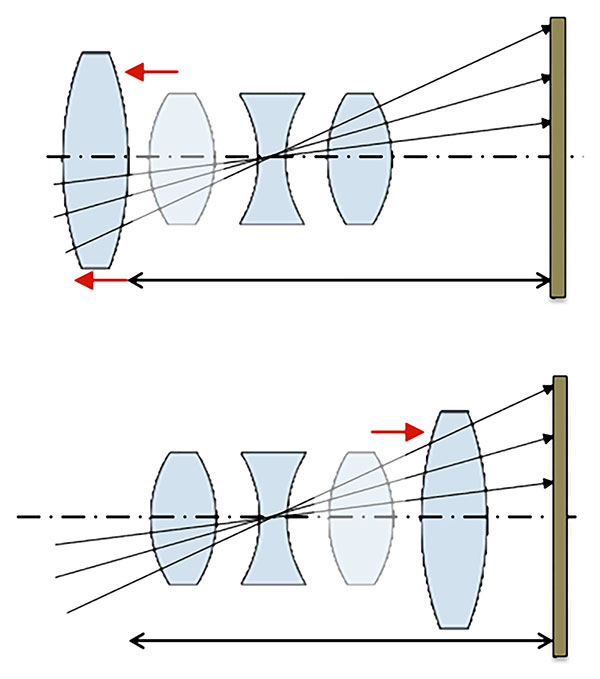
They were quick to say that differences are "easily noticeable"; that is not subtle at all. As an example, the current Canon EF 24-70mm f/2.8L II USM is a very well-regarded lens. (Click the name to see our review of it.) But when compared to the new RF 28-70mm f/2 optic, they said that the new RF-mount lens is as sharp at f/2 as the 24-70 at f/2.8, and only gets better from there. Also while they didn't characterize it with respect to a particular lens, they talked a lot about how much having a large element close to the sensor helped when it comes to correcting aberrations. (I hope to write up a longer discussion of large-mount mirrorless optics at some point, but the overall impact on lens design is pretty significant.)
DANG, that's a big focus element on the 50mm f/1.2! How does that affect AF speed?
High-resolution lenses often have very large focus elements, but we were astonished at just how massive the moving element was in the new Canon RF 50mm f/1.2. Playing with it when we first got our shooting kits, we were a little amazed that we could feel the entire balance of the camera and lens shifting in our hands, as the lens racked from near to far-focus.
While I hadn't had direct experience with it yet when I sat down the engineers, it seemed that such a large focus element must mean slow autofocus speed. Or was there some special focus actuator inside that would compensate for that?
When I asked the engineers about the 50mm f/1.2's focusing speed, they replied that the primary focus when designing that lens was on sharpness, low aberration and bokeh, rather than on focus speed. (So, like many other high-resolution lenses, it probably does focus more slowly.) They also said that the 28-70mm f/2 had similar goals, so focus speed was a secondary concern for it as well.
On the other hand, though, the 24-105mm f/4 kit lens was designed to lean more in the direction of faster focusing. How they achieved that was an interesting story in and of itself.
What is a "Nano-USM" focus actuator?
In discussing the focus speed of the 24-105mm f/4, the engineers mentioned the "Nano-USM" focus actuator. This piqued my curiosity; what does Nano-USM mean? Is it that the little ridges of the ultrasonic motor are smaller, or something else?
The answer was that "nano" is just a good prefix to call attention to the small overall size of the actuators. But they are in fact really, really small.
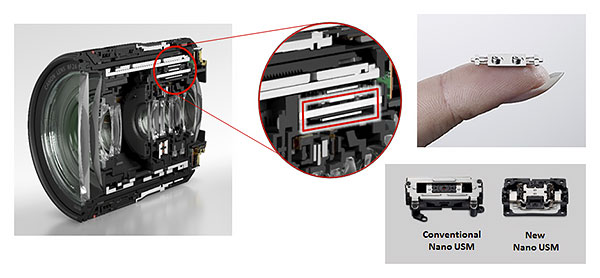
USM motors are usually in the form of rings, circling the lens body, and as such, they add to the lenses' bulk, increasing the diameter of the lens barrel.
In contrast, Canon's Nano-USM actuators are tiny linear motors, more powerful than their diminutive size would suggest. The engineers shared an illustration with me, showing how the Nano-USM units are integrated into the new 24-105mm kit lens (see the image above).
Because the Nano-USM actuators are so small, and are linear motors vs. large rings, the overall diameter of the 24-105mm f/4 lens could be a good bit smaller than it would have otherwise. At the same time, the Nano-USM actuators are apparently quite powerful, despite their having a smaller active area than traditional ring-type designs. We'll see how it plays out in practice, but from the engineers' comments, the 24-105mm kit lens should be pretty quick-footed.
Why so many electrical contacts?
One of the most obvious changes about the new RF mount is the number of electrical contacts it sports. In addition to the standard eight contacts of the EF mount, there are four new contacts, recessed slightly.
As was the case with Nikon's new Z-mount, the reason for the new contacts is to increase the communication bandwidth between the lens and camera body. The old-style 8-contact arrangement comes from decades ago, when the camera and lens needed only infrequent, low-information communication. ("Shift focus to this distance" ... "Are you there yet?" ... "Yes, I am.")
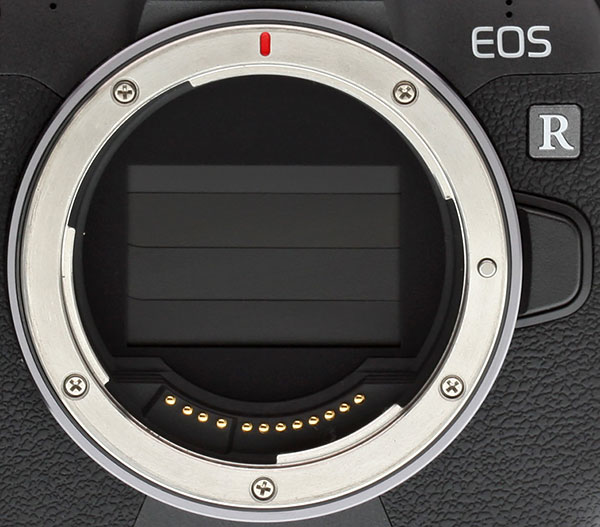
The engineers didn't go into a lot of depth about what sorts of functions needed the increased bandwidth, but one example they gave was that every R-series lens carries a complete set of distortion-, aberration- and diffraction-correction information in an internal memory. All that data gets dumped to the body every time you attach an R-series lens to a body, so it's important to have it happen quickly.
Another use is for the real-time focus-distance information display in the viewfinder. I didn't play with this very much, but it seemed to be extremely responsive to changes in subject distance.
Finally, it turns out that the aperture setting in EOS R lenses can be updated more rapidly (and in steps of just 1/8 EV, vs. the 1/3 EV of EF-series optics). More steps and faster updates benefit from a higher-bandwidth camera/lens connection.
Some contacts aren't currently used(!)
This was interesting: It turns out that not all of the new contacts are actually being used currently! I wondered about the number of added contacts: If they just wanted faster communications, they could have done that with a high-speed serial connection, using just a single pin (assuming there's already a ground contact among the original eight).
When I asked them about this, the reply was that not all of the contacts are being used, but they added extra contacts while they were once changing things, so they'd have expansion ability for the future. (Smart!)
They declined to say what sorts of functions they might be intending for the currently unused contacts, and it's possible that they don't even have specific plans for some of them yet. But I found it very interesting that they've made allowances for future needs this way. (As I've now heard multiple times, they want the RF mount to last them the next 30 years.)
4K video specs, why not better?
While the EOS R's video recording has some very nice video features (MP4/H.264 instead of the previous Motion JPEG recording, at bitrates as high as 480 Mbps at 4K in ALL-I mode and 120 Mbps in IPB mode, ExFAT file system to permit single files larger than 4GB), it's maximum 4K frame rate is 30fps, and 4K shooting imposes a 1.7x crop factor, making 4K wide angle shots difficult.
This is an area where the EOS R lags significantly behind some of its mirrorless competition. In fairness, its full-frame competitors like the Nikon Z7 and Sony A7 III both have the same 30fps limit in 4K, but the Micro Four Thirds Panasonic GH5s can capture at 60fps, and so can the APS-C Fuji X-T3.
When I asked the engineers why the limitations in 4K, their reply was a bit cryptic, mentioning the "CMOS sensor system". A little might have been lost in translation, but I think what it boils down to is that Canon may not yet have the technology to enable full-frame/no-crop 4K readout from their chips.
As noted earlier, this is in fact the same sensor as in the 5D Mark IV, so it's two year old technology at this point. Looking at Canon's other products, the slightly older 1D X Mark II only has a 1.3x crop factor, but it's also only a 20 megapixel sensor. Even the top-of-the-line Cinema EOS C700 camera's sensor isn't a full-frame 35mm, but rather a little larger than the "Super 35" format. So, looking across their line, it looks like 4K readout across a full 35mm frame is an issue for them.
As noted, though, the good news is that the EOS R isn't merely as capable as the 5D IV in doing 4K video, but it has a much improved codec to trim file sizes at the same relative quality as well.
(Also, as Jaron noted in our EOS R deep-dive hands-on video, for current Canon shooters, the tonality and color grading of the EOS R match beautifully with existing cameras like the 1D X II we were using as a second camera. And if you're one of the many people using a 5D IV for video, the EOS R has essentially identical capability at ~2/3 the price.)
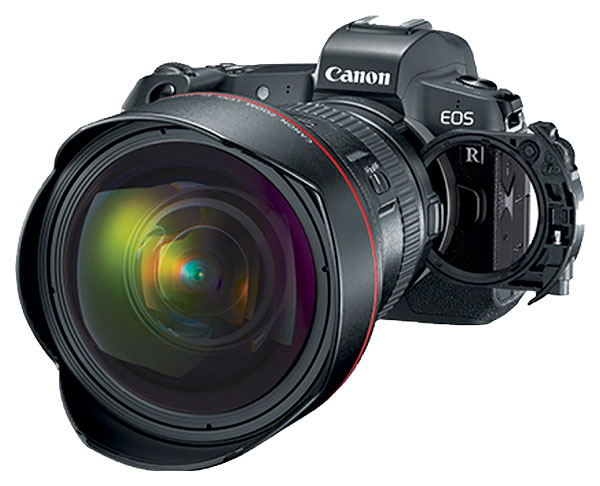
Summary
First, I want to extend my thanks to the Canon engineers who made the long trip from Japan to meet with us, and who were almost certainly even more jet-lagged than myself when we met. Domo arigatou gozaimasu!
As you can see, it was an interesting session! I was particularly intrigued by their answers about choice of flange depth, and the workings of the AF system. The insights into the benefits that the new flange and back-focus options brought to their lens designs were also very welcome. (As I mentioned, I have more to add about this, but it will have to wait for a separate article or video.)
Please share your thoughts below (but as always, please maintain the air of civility and respect that our comments sections are known for). Likewise, feel free to post any additional questions you might have, and we'll gather them together to ask our PR and engineering contacts within Canon!
And as always, if you're considering purchasing an EOS R and lenses, please use our affiliate links below.
Doing so doesn't cost you a penny more, but really, really helps us keep producing the sort of unbiased, detailed information we're known for. Pre-orders that end in purchases count just as much as immediate deliveries; I can't say enough how much your purchases through our links help us. Thank you!
Your pre-orders help this site!
Ordering through the links below will cost you nothing, but will be a huge help in supporting the work we do.
Canon EOS R Body Only: Adorama ($2,299.00) | B&H Photo ($2,299.00)
Canon EOS R Kit with 24-105mm lens: Adorama ($3,399.00) | B&H Photo ($3,399.00)
Canon RF 24-105mm f/4L lens: Adorama ($1,099.00) | B&H Photo ($1,099.00)
Canon RF 28-70mm f/2L lens: Adorama ($2,999.00) | B&H Photo ($2,999.00)
Canon RF 35mm f/1.8 Macro lens: Adorama ($499.00) | B&H Photo ($499.00)
Canon RF 50mm f/1.2L lens: Adorama ($2,299.00) | B&H Photo ($2,299.00)
Thank you!
• • •
Want to know even more about the Canon EOS R mirrorless camera, its brand-new RF-mount
and the initial round of RF lenses? Read our detailed coverage of each below: